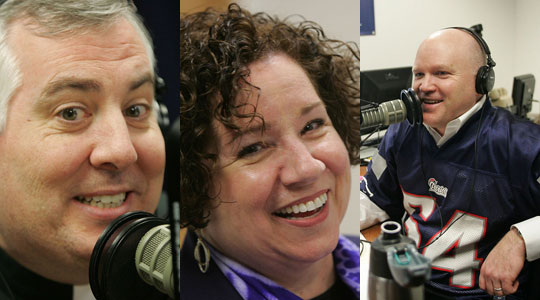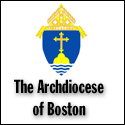Listen to the show:
Podcast: Play in new window | Download
Today’s host(s): Scot Landry and Fr. Mark O’Connell
Today’s guest(s): Dr. Mary Grassa-O’Neill, Superintendent of Catholic Schools, and Jim Walsh, Associate Superintendent for Finance and Administration
Links from today’s show:
Today’s topics: Catholic Schools Week: Wrapup
Summary of today’s show: In our last show of Catholic Schools Week, Scot Landry and Fr. Mark O’Connell welcome Mary Grassa-O’Neill and Jim Walsh from the Catholic Schools Office to give listeners more examples of how Catholic schools around the Archdiocese celebrated, including students performing in Chinese at Boston College High and a human rosary at Holy Family in Rockland. They then discussed the success of Catholic schools in Boston, including the first rise in enrollment in decades and tools for principals and pastors to use to better ensure financial viability and strategize for future success in ensuring every child who wants an education steeped in the Catholic faith can have one.
1st segment: Scot and Fr. Mark discussed the Super Bowl on Sunday then discussed the meeting of the Cardinal’s Cabinet. Fr. Mark said the meeting was very forward-looking. Fr. Mark said it’s also the Feast of St. Blaise and he’s been blessing many throats today. On the day after the Feast of the Presentation, on which the candles are blessed, the candles are used for the blessing. He offered the same blessing to anyone who hadn’t been able to receive it today.
2nd segment: Scot and Fr. Mark welcomed Mary and Jim to the show. Scot asked Mary for her highlights of the week. She said it’s exciting because there are so many activities. She said it begins with the special themed Masses, many of which take place in the parishes last Sunday and others which have them each day.
BC High had a program this week called “Chinese Idol,” in which students performed in Chinese, to encourage them to continue to learn Chinese and learn Chinese culture. They were accompanied by an all-strings orchestra from Beijing. They offer nine levels of Chinese instruction and send students to China each year. She said we have to do more in our schools to prepare students for engaging Asian cultures in the future. Pope John Paul II Catholic Academy in Neponset also had a big Chinese celebration.
Meanwhile, Holy Family School in Rockland did a human rosary, with each student being one of the prayers. St. Agatha’s in Milton had a standing-room only Mass that had over 600 students plus more from the community. Trinity Catholic in Brockton had the mayor and public school superintendent come in to read to the children and they had career days. That is a big school as well with 560 students on two campuses.
Mary said the National Catholic Education Association provides suggestions, but schools come up with their own ideas. Quincy Catholic Academy students learned about filmmaking and made stop-motion movies. Other schools take educational field trips. Scot said there seems to be three purposes: school spirit, highlight the Catholic identity, and market the schools to potential students. Jim said it’s also an opportunity to celebrate the sense of community. Many honor and give tribute to the religious orders that founded and staffed those schools, teaching about former principals and teachers, for example. They welcome in former students as well as parents and grandparents to see what’s going on in the schools.
Fr. Mark talked about the connection between the pastors of the parish and the schools. Mary told a story of one child with cancer at St. Mary in Melrose who had chemo but was afraid to come back with no hair so the pastor, Fr. Sullivan, got a local barber and five classmates (with permission of their parents) and they all shaved their heads in solidarity, Fr. Sullivan too.
Scot said Catholic Schools Office has three main themes: Strengthening Catholic identity, enhancing academic excellence, and giving vitality to finances. Mary said academic excellence is critical because it’s using God’s gifts to their fullest. Fr. Mark said not all students are Catholic and we have a mission to educate everyone. Mary said 82% of students are Catholic, and non-Catholic students know they will be asked to participate in the Catholic life of the schools.
Scot said Jim also participates in Catholic Schools Week as a parent with children at Xaverian Brothers in Westwood and St. Catherine of Siena in Norwood. He talked about how his own kids took part in events at their schools. He said they had open houses for potential students and their families next year.
3rd segment: Mary told a story of how the students and teachers of St. Catherine’s in Norwood lined the streets during the funeral procession of a soldier who died in Afghanistan. The students held their hands over their hearts and waved flags silently to give comfort to the soldier’s family and promote the Gospel ideal of laying one’s life down one’s friends.
Jim said there are 123 Catholic schools in the Archdiocese, 89 of them are Archdiocesan parish or Archdiocesan-related schools. Some schools are separately incorporated or owned by religious orders. All of the schools participate in archdiocesan events. The five Catholic colleges also participate and cooperate with the Catholic Schools Office.
Mary said there are many Catholic school leaders and the team at CSO help focus on Catholic identity, excellence in academics, and a strong and viable business plan. She said one example of a Catholic school that’s taken their help to heart is St. Agnes in Arlington. They had an assessment of their business plan and completely redesigned it so that the parish no longer has to provide financial support to the Catholic.
The CSO undertook a study of the business plans and finances of all the Catholic elementary schools and came up with a snapshot of each school and a tool to help monitor and track how the school is doing over time. It gave a whole new vocabulary to pastors and principals because they’re not usually trained in business. In the past, the Archdiocese would sometimes hear of a school in distress at the last minute and this tool helps the CSO to monitor schools and give assistance long before the situation gets desperate.
Scot asked Jim how the CSO helps schools that are in the danger. He noted that school enrollment in Catholic schools is up for the first time in decades. Jim said schools have generally fallen into three zones, red, yellow and green. They’ve used this “dashboard” tool to help schools under the metrics that drive the viability of schools, keeping in mind the competitive environment for private schools. The CSO has had several workshops to teach school leaders to understand the metrics and develop a strategy. For example, they’re showing schools to strategize their funds to increase ongoing income as opposed to single-time gifts.
Scot said a key to a successful Catholic school is the principal and asked how they look for a good fit for each school. Mary said they have helped 45 schools find a new principals in the past few years. They help the school define the job requirements and what they’re looking for, hold parish meetings, help form screening committees, and provide other assistance. Mary said our principals are very talented, especially when you see the results. Catholic school students are far outpacing their public school peers in achievement of all kinds. Yet the principals are being compensated, in general, at well below market rate.
Scot said a part of the success is getting the word out about the value of Catholic education. Mary said we have to promote our own good news. Catholic school students graduate at a 98% rate, ethnic minorities do better than their public school counterparts, and Catholic school students attend college at a higher rate. Part of the reason is that our people really care about Catholic education, invest a lot of themselves, and focus on what it is they’re trying to accomplish.
Jim said he’s proud of a number of initiatives and recommendations that have taken place in recent years. One of the first was the opening of Trinity Catholic Academy in Brockton. It has a stable enrollment base and many pastoral, educational and social service programs such that the school is often the best thing happening in those kids’ lives. He then spoke of Pope John Paul II Catholic Academy which has 1,300 students on four campuses in Boston’s inner city.
They’ve now create a Xaverian Brothers-sponsored Catholic high school in Lowell, which is now at capacity with a waiting list. Jim said these intiatives help build the Church in urban areas, but also help stabilize neighborhoods. He cited the example of the St. Peter teen center at Pope John Paul II that provides a place for children well into the night.
Mary said Catholic schools provide benefits that surpass your expectations including learning in a Christ-centered environment that promotes a sense of teamwork, community, and caring.
4th segment: Now as we do every week at this time, we will consider the Mass readings for this Sunday, specifically the Gospel reading.
Job spoke, saying:
Is not man’s life on earth a drudgery?
Are not his days those of hirelings?
He is a slave who longs for the shade,
a hireling who waits for his wages.
So I have been assigned months of misery,
and troubled nights have been allotted to me.
If in bed I say, “When shall I arise?”
then the night drags on;
I am filled with restlessness until the dawn.
My days are swifter than a weaver’s shuttle;
they come to an end without hope.
Remember that my life is like the wind;
I shall not see happiness again.
- Gospel for February 5, 2012, Fifth Sunday in Ordinary Time (Mark 1:29-39)
On leaving the synagogue
Jesus entered the house of Simon and Andrew with James and John.
Simon’s mother-in-law lay sick with a fever.
They immediately told him about her.
He approached, grasped her hand, and helped her up.
Then the fever left her and she waited on them.When it was evening, after sunset,
they brought to him all who were ill or possessed by demons.
The whole town was gathered at the door.
He cured many who were sick with various diseases,
and he drove out many demons,
not permitting them to speak because they knew him.Rising very early before dawn, he left
and went off to a deserted place, where he prayed.
Simon and those who were with him pursued him
and on finding him said, “Everyone is looking for you.”
He told them, “Let us go on to the nearby villages
that I may preach there also.
For this purpose have I come.”
So he went into their synagogues,
preaching and driving out demons throughout the whole of Galilee.
Scot said in these readings, suffering is very present. In the first reading we only hear part of the story of Job, in which people doubted Job’s faithfulness because he was so blessed. So the blessings were withheld and remained faithful to God. In the Gospel there was much suffering as well and those sufferers came to Jesus and were healed. Fr. Mark said the message of Job is incomplete. The completion of the message of sacrifice and the problem of pain is in the healing message of Jesus.
Mary said the first reading makes her think how love of God and faithfulness comes from within.
Scot said in the Gospel Jesus healed people one on one. He didn’t heal whole crowds at once, but brought his love to the individual. Jim said when we are praying, our prayer sustains us in those difficulties. Often when we pray, we can recognize those who come into our lives as an answer to prayer. Our prayer life sustains us.
Fr. Mark said Jesus is the busiest person around. He’s got three years to do everything and people are flocking to him, but notice how the Gospel writers say he rose and went to prayer. He always found time to pray. There’s no one busier than our Lord, but he finds time to pray.








Comments Closed